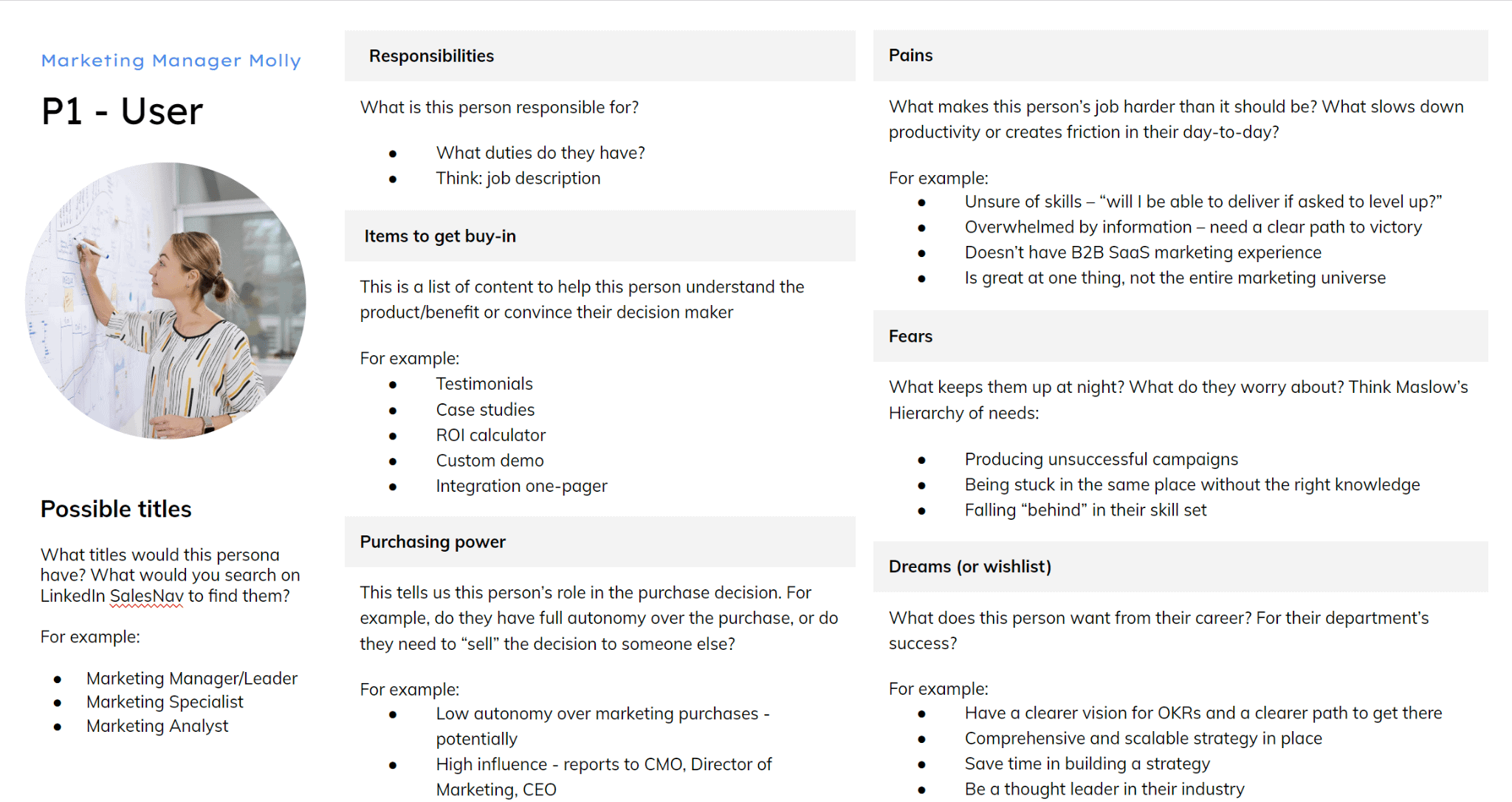Traditionally, B2B sales were about meeting prospects for lunch, negotiating prices, and closing the deal.
Today, sales strategies for B2B looks drastically different. Powered by automation and technology, B2B buyers are more intelligent, follow an intricate research process, and take a multi-step approach to make a purchase decision. Put simply, they expect more.
The question is: how can you match buyers’ expectations and thrive in a constantly advancing market?
Instead of following a spray-and-pray approach, we’ve curated a list of six B2B sales strategies to help you win more qualified leads and skyrocket your conversion rates. These six strategies will give you the right direction to impress buyers and convince them to purchase.
Know Your Clients Better Than Your Competitors
No matter how much time and money you invest, your sales strategy is bound to fail if you’re not clear on who you’re selling to. That’s why the first and most important strategy for driving sales for your B2B business is understanding your customers inside out.
Creating buyer personas is an effective way to identify and define your ideal customers. A well-designed bill of sale template can help formalize your B2B transactions and provide clear documentation for both parties. A buyer persona outlines specific characteristics, pain points, needs, and goals to represent a group of prospects.
Here’s an example of what a buyer persona looks like. This detailed persona includes multiple insights like pains, fears, dreams, and more, to help sales reps personalize their pitch for these buyers.

Besides personalizing your communication with prospects, creating buyer personas can also allow you to price your services appropriately for every lead. You can offer customized pricing based on their needs and scope of work.
Here are a few factors to consider when designing your B2B buyer personas:
- Demographic: These are demographic traits like age, location, industry, income, gender, and more
- Psychographic: These are personal factors that distinguish every buyer, like preferences, personality, personal story, dislikes, work motivation, and more
- Goals and priorities: These are the organizational goals they want to achieve through the desired solution
- Readiness to change: This indicates their capability to change to a different brand/service provider
- Role in the buying process: This indicates their role and influence in the buying process
- Motivations and drivers: This summarizes their needs for buying your product/service and the pain points they want to eliminate
B2B teams can work with marketing mentors to narrow their prospects and define multiple buyer personas. Use these personas to shape the other parts of your sales strategy, like prospecting, nurturing, engaging, and closing.
Leverage LinkedIn & Social Selling to Feed Your Funnel
Social selling is using social media to generate and nurture leads. For B2B companies, social selling has been synonymous with LinkedIn since the beginning. But limiting your strategy to LinkedIn won’t cut it anymore.
Here are three proven ways to embrace social selling and supercharge your sales setup:
Organic Posting
To succeed at social selling, you have to demonstrate your expertise and position your brand as a trusted industry leader. When selling to an informed audience, you need to win their trust
by proving how you can solve their pain points.
![Sales strategies for B2B - Bulkly - 2 Sales strategies for B2B - 6 Sales Strategies for B2B in '2025' [Maximize Results] - 1](https://bulk.ly/wp-content/uploads/2023/02/word-image-30349-2.png)
Source: LinkedIn feed
But while most B2B teams are aware of these, they struggle to create and publish content to achieve these objectives. This is where a social media automation tool like Bulk.ly can do the job for you.
Bulkly can help you create, schedule, recycle, and analyze social media posts. The tool is designed to take over your end-to-end social media marketing strategy, saving you the time and budget to generate leads from your chosen channels. You can:
- Upload your posts in bulk
- Automatically create new status updates
- Organize and schedule posts
- Get constant reports
![Sales strategies for B2B - Bulkly - 3 Sales strategies for B2B - 6 Sales Strategies for B2B in '2025' [Maximize Results] - 2](https://bulk.ly/wp-content/uploads/2023/02/word-image-30349-3.png)
Paid Social
Another way to boost your social selling efforts is by running paid ads on social media platforms. 77% of B2B marketers use social media ads to reach the right people and generate high-quality leads.
![Sales strategies for B2B - Bulkly - 4 Sales strategies for B2B - 6 Sales Strategies for B2B in '2025' [Maximize Results] - 3](https://bulk.ly/wp-content/uploads/2023/02/word-image-30349-4.png)
B2B companies can use paid social for:
- Building brand awareness and discoverability
- Nurturing leads throughout the buyer’s journey
- Promoting targeted content to get more views
![Sales strategies for B2B - Bulkly - 5 Sales strategies for B2B - 6 Sales Strategies for B2B in '2025' [Maximize Results] - 4](https://bulk.ly/wp-content/uploads/2023/02/word-image-30349-5.png)
Source: LinkedIn feed
As a best practice, create a landing page for your social media ads to give interested buyers a quick glimpse of what you can offer. Then send them down the funnel through frequent brand exposure.
Outreach
Besides running paid campaigns and posting content, B2B teams can also perform social selling through outreach—directly approaching prospective customers and pitching your brand.
This is where using LinkedIn will shine. LinkedIn gives you access to the key decision-makers from companies in your lead database. Once you know who you’re selling to, automate your LinkedIn outreach to reach out to your prospects at scale by sending automated connection requests, introductory messages, and more.
You can also use prospecting emails to reach people in your leads list. Collect and verify their emails, then design an email outreach campaign with follow-ups.
Think & Act Multichannel to Meet Buyers Where They Are
If you think your buyers will only visit your website and talk to a sales rep to research before a purchase decision, here’s the kicker: the B2B buying journey isn’t linear anymore.
Gartner illustrates how buyers don’t move in a predictable sequence to choose vendors for solving their pain points. Instead, they go through a maze of steps to identify the problems, explore potential solutions, map their ideal requirements, and select suitable vendors.
![Sales strategies for B2B - Bulkly - 7 Sales strategies for B2B - 6 Sales Strategies for B2B in '2025' [Maximize Results] - 6](https://bulk.ly/wp-content/uploads/2023/02/word-image-30349-7.png)
One thing is clear: you can’t stick to only one platform for converting these buyers. You need a multichannel sales strategy to increase visibility, consistently expose buyers to your brand, and reiterate your offer.
Here are a few tips for meeting prospects where they are with an integrated multichannel outreach campaign:
- Be crystal clear about your ideal customer profile and identify their pain points to personalize their buying experience
- Design a cross-channel promotion strategy to coordinate your posts on Instagram, TikTok, Facebook, and other platforms
- Use a social media automation platform like Bulkly to connect your social accounts and post consistently across all accounts
- Leverage email and SMS for texting leads and nudging them toward a purchase decision through value-added content
The bottom line: your buyers are everywhere. Broaden your selling strategy and give prospective customers a cohesive brand experience with multichannel campaigns.
Ask the Right Questions and Listen to Win Buyers’ Trust
The highest yielding B2B sales reps have a 1:2 talk-to-listen ratio—that means they let their prospects talk most of the time in a sales conversation. This reveals two key facts:
- One, intently listening to your prospects can unlock new selling opportunities
- Two, sales reps talking less and letting prospects talk more can lead to more conversions
Encouraging your prospects to talk can give you a lens into their pain points and help you perform a needs analysis. It helps identify exactly what they need, enabling you to personalize your offer. Moreover, when you’re aware of a prospect’s specific problems, you can deliver a targeted post-purchase experience to maximize the customer lifetime value.
![Sales strategies for B2B - Bulkly - 8 Sales strategies for B2B - 6 Sales Strategies for B2B in '2025' [Maximize Results] - 7](https://bulk.ly/wp-content/uploads/2023/02/word-image-30349-8.png)
Using scored surveys is one way to collect enough information about your prospects before a sales call. You can design these surveys for learning more about your prospects through objective answers and custom scoring.
Once you have this information, you can:
- Ask open-ended questions to hear your buyers’ take on a subject and get their insights
- Take buyers on a journey of self-discovery and help them get more clarity on their needs
- Validate your insights by asking confirming questions and reiterating pain points
- Build a better rapport by showing prospects how well you understand them
- Steer the conversation toward diagnosis and treatment of their problems
The goal behind talking less and listening more is to gradually lead prospects to the realization that they need your product/service. Use this technique to skip the spammy sales talk and hold more meaningful conversations with your buyers.
Engage Your Prospects Without Being Pushy
One of the biggest challenges of the B2B sales cycle is cutting through the noise and setting your brand apart from the competition. While there’s no secret recipe to do that, focus on engaging your prospects to deliver an exceptional buying experience and convert more prospects.
Follow these popular tactics to engage B2B buyers:
- Blogs: Create educational content optimized for search to maximize discoverability on search engines, position yourself as an industry leader, and leverage inbound marketing. You can also publish bottom-of-the-funnel content to convince customers to make a purchase.
- Social media: Use social media platforms like LinkedIn and Twitter to show your brand personality and engage prospective buyers. Publish content regularly with tools like Bulkly to reach your intended audience. You can also run ads or promote posts to increase views.
- Virtual events: Host webinars, chats with industry experts, and networking events to collect and nurture your leads. Add CTAs to your sales page and encourage leads to learn more about your business, talk to a sales rep, or sign up for a demo.
- Email marketing: 31% of B2B marketers consider emails the most effective way to nurture leads. Design personalized newsletters and emails to actively engage your prospects. Share discount coupons, the latest announcements, and feedback surveys to give them enough reasons to buy from you.
Focus on building relationships with potential customers instead of pushing them to buy. These tactics will gradually take prospects from awareness to purchase.
Automate Sales Workflows to Maximize Efficiency
Sales automation involves multiple sales tools to automate certain manual and repetitive tasks in the standard cycle. Automation can take care of the mechanical tasks to free up your reps’ time for 1:1 conversations and sales engagement.
Here are a few ways to incorporate automation into your sales process:
- Prospecting: Generate leads from different channels and verify their contact information through automation tools. Perform cold outreach on social media and emails through automated workflows.
- Nurturing: Create personalized email sequences to nurture leads in different stages of the funnel. Create an engaging welcome email, followed by several steps of a drip campaign. Share valuable content that is appropriate to the level and offer regular contact with your sales reps.
- Scoring: You can also score leads and initiate your nurturing campaigns for leads qualifying the base threshold.
![Sales strategies for B2B - Bulkly - 9 Sales strategies for B2B - 6 Sales Strategies for B2B in '2025' [Maximize Results] - 8](https://bulk.ly/wp-content/uploads/2023/02/word-image-30349-9.png)
- Engagement: Put your marketing efforts on auto-pilot to engage leads throughout their buying journey. Bulkly can do the heavy lifting on your behalf to create, organize, and schedule social media posts. Use flexible posting options to set up your workflows and stay in complete control of your marketing automation.
![Sales strategies for B2B - Bulkly - 10 Sales strategies for B2B - 6 Sales Strategies for B2B in '2025' [Maximize Results] - 9](https://bulk.ly/wp-content/uploads/2023/02/word-image-30349-10.png)
- Closing: Automate and streamline the process of closing a sale. A contract management software is the perfect solution for setting up a review and approval process with relevant alerts to notify the right people when a prospect is ready to buy.
It quickly becomes clear that a multi-channel approach with its various stages can only be implemented if a high degree of automation is achieved. Marketing automation is your best friend to make this complex challenge manageable.
Bringing it All Together: A Path to Success in B2B Sales
B2B buyers want to be in the driver’s seat throughout the sales process. This means you have to rethink your strategies where sales reps play a secondary role and buyers have more control over their journeys.
With the six strategies discussed in this article, you’re all set to win over your buyers with targeted and highly engaging sales campaigns.
Remember to be a guide for your buyers instead of a pushy salesperson. Build your marketing automation framework with tools like Bulkly to give your team more time for meaningful selling.


![Sales strategies for B2B - Bulkly - 6 Sales strategies for B2B - 6 Sales Strategies for B2B in '2025' [Maximize Results] - 5](https://bulk.ly/wp-content/uploads/2023/02/word-image-30349-6.png)